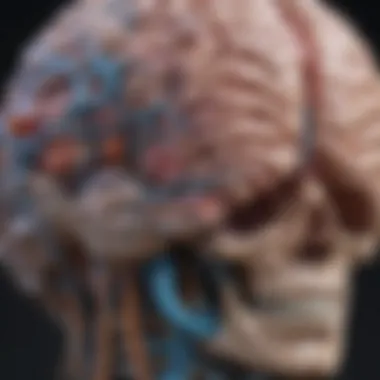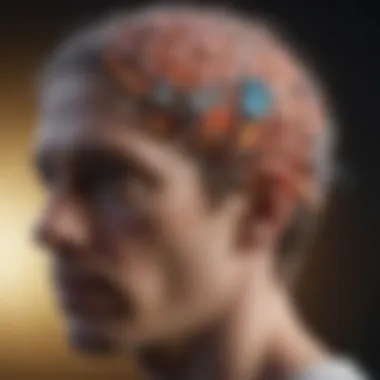Understanding Brain Mapping: Techniques and Applications


Intro
Brain mapping represents a significant stride in neuroscience, allowing researchers to dissect the complexities of the human brain. Through various imaging techniques, scientists can visualize the brain’s architecture and functionality in unprecedented ways. This article aims to delve into the methodologies adopted in brain mapping, highlight key research findings, and discuss the applications and future directions of this field. Understanding how the brain operates, both in health and disease, is crucial for advancing medical and psychological sciences.
Key Research Findings
Overview of Recent Discoveries
Recent advances in brain mapping have propelled our understanding of cognitive functions and neurological disorders. For instance, functional Magnetic Resonance Imaging (fMRI) has made it possible to observe brain activity in real time, providing insights into how different regions interact during specific tasks.
Neuroscientists have utilized techniques like Diffusion Tensor Imaging (DTI) to study brain connectivity, revealing the pathways that govern communication among neurons. These discoveries have underscored the importance of connectivity patterns in conditions such as schizophrenia and autism. Research also emphasizes the plasticity of the brain—its ability to adapt and reorganize itself based on experience or injury, which is a promising area for therapeutic interventions.
Significance of Findings in the Field
The implications of these findings extend beyond academic interest. They play a vital role in clinical settings, shaping how treatments for neurological disorders are conceptualized. For example, the understanding of neural pathways has direct applications in rehabilitative therapies for stroke patients. With this knowledge, effective strategies can be developed to aid recovery.
Furthermore, recognizing the relationship between brain structure and cognitive abilities allows for the potential early detection of cognitive decline. This foresight is crucial for developing preventive measures in aging populations.
Recent studies have shown that early interventions can significantly influence brain recovery, thereby enhancing overall outcomes in neurological rehabilitation.
Breakdown of Complex Concepts
Simplification of Advanced Theories
Brain mapping involves sophisticated theories that may seem daunting at first. However, breaking down these concepts can aid in comprehension. One primary theory is the localization of function, which posits that specific brain regions are responsible for certain functions, like language or memory. Understanding this theory facilitates insight into how various brain disorders affect these functions.
Visual Aids and Infographics
Using visual aids can further simplify these advanced concepts. Infographics can illustrate the following:
- Different brain imaging techniques such as fMRI, PET, and EEG.
- The brain's anatomy and the functions associated with various lobes.
- Diagrams showing the neural circuitry involved in specific cognitive processes.
These visual tools can enhance retention of complex information, making it easier for students, researchers, and professionals to grasp critical concepts around brain mapping.
Intro to Brain Mapping
Brain mapping is a significant domain within neuroscience that seeks to decode the complexities of the human brain. With each passing year, advancements in technology further illuminate the inner workings of the brain, from its structural frameworks to the intricate connections that shape behavior and cognition. Understanding brain mapping is therefore essential, as it not only plays a crucial role in diagnosing neurological disorders but also opens pathways for innovative treatments and interventions.
The importance of this topic cannot be overstated. Brain mapping provides critical insights that aid clinicians in understanding various brain-related conditions. For instance, conditions such as epilepsy, dementia, and traumatic brain injuries can be better managed through accurate brain mapping techniques. The benefits extend beyond clinical settings; researchers utilize these techniques to unravel the mysteries of cognitive processes, enhance our understanding of learning and memory, and explore the vast capabilities of the brain.
Defining Brain Mapping
Brain mapping refers to the collection of methodologies used to visualize the structure and function of the brain. This field combines neuroimaging, electrophysiology, and computational neuroscience to provide a comprehensive understanding of brain activities. The primary goal is to identify brain areas responsible for distinct functions, which can include everything from basic motor skills to complex cognitive tasks.
The techniques used in brain mapping can be broadly classified into two categories: functional and structural imaging. Functional imaging highlights brain activity in real-time, while structural imaging focuses on the anatomy, identifying regions and pathways within the brain. This dual approach allows for a more nuanced understanding of the brain, illuminating the relationship between structure and function.
Historical Context
To contextualize the evolution of brain mapping, one must look back at the early neurological investigations. The initial efforts in understanding brain functions can be traced to early experiments with patients suffering from seizures. These cases led to the identification of specific brain regions linked to particular functions.


The advent of technologies such as X-ray imaging in the early 20th century marked the beginning of more sophisticated approaches. However, it wasn't until the development of Magnetic Resonance Imaging (MRI) in the late 20th century that brain mapping saw a significant transformation. MRI enabled researchers to create more detailed images of the brain and its functions without invasive procedures. As technology progressed, newer methods such as Positron Emission Tomography (PET) and functional Magnetic Resonance Imaging (fMRI) emerged, allowing clinicians to visualize brain activity during cognitive tasks.
"The timeline of brain mapping reflects the merging of technological advances with neuroscience, leading to a deeper understanding of the human brain."
Today, the field continues to grow, fueled by both technological innovation and interdisciplinary collaboration. The historical milestones highlight how far we have come in understanding the brain and set the stage for future advancements that promise to unravel even more mysteries.
Methodologies in Brain Mapping
The field of brain mapping encompasses various methodologies that are critical for understanding complex neural processes. Utilizing diverse techniques enables scientists to obtain a multifaceted view of the brain's structure and functionality. These methodologies allow for a deeper comprehension of neurological disorders, cognitive functions, and the overall brain organization. Each technique has its own specific characteristics and applications, making it essential to consider which is most appropriate for a given research or clinical scenario.
Functional Imaging Techniques
Functional imaging techniques focus on observing brain activity in real time, giving insights into how different areas function during tasks or at rest. This approach plays a significant role in understanding cognitive processes, emotional responses, and various neurological diseases. Two prominent techniques in this category are Positron Emission Tomography and Functional Magnetic Resonance Imaging.
Positron Emission Tomography (PET)
Positron Emission Tomography, or PET, is a functional imaging method that visualizes metabolic processes in the brain. By introducing a radioactive tracer, researchers can observe blood flow and brain activity associated with specific functions. One key characteristic of PET is its ability to detect changes in metabolic activity, making it an invaluable tool for studying conditions like Alzheimer's disease or epilepsy.
However, the main disadvantage of PET lies in its relatively low resolution when compared to other imaging modalities. The use of radioactive substances also raises safety concerns, although the doses are typically low and considered safe under clinical guidelines. Nevertheless, PET remains a popular choice for researchers because it provides qualitative data regarding brain function that other techniques may not offer.
Functional Magnetic Resonance Imaging (fMRI)
Functional Magnetic Resonance Imaging focuses on measuring brain activity by detecting changes in blood flow. This technique is particularly advantageous because it does not require radiation exposure, making it safer for repeated studies. The key characteristic of fMRI is its high spatial resolution, allowing for mapping brain functions with great precision.
Despite its advantages, fMRI has its limitations. It is less effective in capturing rapid neural activities and can be limited by subject movement during scanning. Nonetheless, fMRI's capability to provide insights into real-time cognitive processes makes it an essential technique in both clinical and research settings.
Structural Imaging Techniques
Structural imaging techniques concentrate on providing a detailed view of brain anatomy. They are essential for identifying abnormalities and understanding the relationships between brain structures and functions. The two main structural imaging techniques are Computed Tomography and Magnetic Resonance Imaging.
Computed Tomography (CT)
Computed Tomography uses X-rays to produce cross-sectional images of the brain, allowing for the assessment of structural abnormalities like tumors or hemorrhages. One key aspect of CT is its speed; it provides rapid imaging, which is crucial in emergency settings where time is essential.
However, while CT is quick and widely available, it comes with the drawback of higher radiation exposure compared to other imaging techniques. The resolution is also lower than that offered by MRI. Therefore, although CT is beneficial for initial assessments, MRI is often recommended for more detailed evaluations.
Magnetic Resonance Imaging (MRI)
Magnetic Resonance Imaging is known for its exceptional detail in depicting brain structures without using ionizing radiation. It utilizes strong magnetic fields to generate images, showcasing soft tissue and brain anatomy with high clarity. Its primary advantage is the detailed visualization it provides, which is crucial for diagnosing various neurological conditions.
On the downside, MRI scans take longer than CT scans and can be uncomfortable due to the enclosed spaces involved. Additionally, MRI is sensitive to motion, which can sometimes affect image quality. Despite these issues, MRI is favored for its non-invasive nature and detailed structural imaging capabilities.
Electrophysiological Techniques
Electrophysiological techniques involve the measurement of the electrical activity of neurons. These techniques provide a direct insight into the brain's functional dynamics, making them vital for understanding neural processes. The two most notable electrophysiological methods are Electroencephalography and Magnetoencephalography.
Electroencephalography (EEG)
Electroencephalography is a method used to record electrical activity in the brain using sensors placed on the scalp. One major advantage of EEG is its superb temporal resolution; it can capture rapid neural events as they occur. This makes it exceptionally useful for studies on brain activity during cognitive tasks.


However, EEG has spatial resolution limitations, making it challenging to pinpoint the exact source of electrical signals within the brain. Despite this, EEG is a valuable tool in clinical settings, particularly for diagnosing seizure disorders.
Magnetoencephalography (MEG)
Magnetoencephalography detects magnetic fields generated by neuronal activity. This technique offers high temporal and spatial resolution, making it ideal for precise mapping of brain function. MEG is advantageous because it provides a non-invasive means of monitoring brain activity in real-time.
The downside is that MEG systems are costly and require specialized environments to minimize magnetic interference. Despite these challenges, MEG's precision in mapping dynamic brain functions makes it a potent choice for researchers and clinical applications.
Applications of Brain Mapping
Applications of brain mapping encompass a broad range of practical uses in both clinical and research settings. These applications are pivotal in enhancing our understanding of brain function and pathology. By leveraging brain mapping techniques, professionals can make significant strides in diagnosing neurological conditions, planning surgical interventions, and further exploring cognitive processes. The comprehensive understanding gained from applying these methodologies can lead to improved patient outcomes and informed scientific research.
Clinical Applications
Diagnosis of Neurological Disorders
The diagnosis of neurological disorders using brain mapping is a crucial application. Techniques such as fMRI and PET scans facilitate the identification of abnormalities in brain structure and function. This capability allows for earlier and more accurate diagnoses, a significant advantage in treating conditions like Alzheimer’s disease or epilepsy. The unique feature is the ability to visualize metabolic and blood flow changes. This feature enhances the diagnostic process, making it a valuable tool in neurological health. However, the costs associated with advanced imaging may limit access for some patients.
Surgical Planning and Guidance
Surgical planning and guidance benefit markedly from brain mapping technologies. Procedures like tumor resections often require detailed knowledge of brain areas responsible for critical functions. Brain mapping aids surgeons by providing real-time data to avoid damaging essential tissues during operations. Its key characteristic lies in its precision and real-time feedback capabilities. Such features are critical for improving surgical outcomes and minimizing risks. The challenge remains in the learning curve for surgeons to interpret and utilize the data effectively.
Research Applications
Understanding Cognition and Behavior
Understanding cognition and behavior is an essential research application of brain mapping. Functional imaging techniques reveal how different brain areas contribute to cognitive processes such as memory, attention, and perception. This aspect is particularly beneficial in exploring behavioral changes associated with various conditions. The unique feature is its ability to capture brain activity during specific tasks, offering insight into cognitive mechanisms. The downside is the difficulty in isolating variables that affect behavior, which may complicate analyses.
Studying Brain Plasticity
Studying brain plasticity is another critical area of research within brain mapping. This concept refers to the brain's ability to adapt and reorganize itself in response to experience or injury. Techniques such as MRI allow researchers to examine these changes over time. The primary advantage is the illumination of how learning and rehabilitation strategies can facilitate recovery or improvement in function. Despite its potential, researchers must navigate the complex timeline of neural changes, which can be challenging to measure accurately.
Challenges in Brain Mapping
Brain mapping, while a powerful tool, encounters several challenges that must be addressed for effective use. These challenges can limit our understanding of the brain and its functionalities. Acknowledging these limitations is crucial for both researchers and clinicians. The importance of these challenges lies in their potential to skew results and misinform treatment options. Addressing these issues is vital to maintain the integrity of neuroscience as a field.
Technical Limitations
Resolution and Accuracy Issues
Resolution and accuracy are significant aspects of brain mapping. High-resolution images are essential for identifying small structures in the brain. Poor resolution may result in crucial details being lost. In brain imaging techniques like fMRI, achieving high resolution is often limited by the equipment's capabilities. This characteristic makes it a popular focal point in research and clinical applications. The unique feature of resolution issues is that they can directly affect the diagnosis of disorders. For instance, in neurological assessments, low-resolution images may lead to misdiagnosis. This can have serious implications on patient treatment decisions. Therefore, improvements in resolution technology are constantly pursued, but they often come at the expense of imaging speed and volume. In summary, resolution and accuracy are foundational to maximizing the efficacy of brain mapping.
Data Interpretation Challenges
Data interpretation presents another hurdle in brain mapping. The complexity of data produced from various imaging techniques requires robust analytical frameworks. Misinterpretation can lead to incorrect conclusions about brain function. The key characteristic here is the multi-dimensional nature of brain data, which can be overwhelming. This complexity is a notable consideration for researchers aiming to derive meaningful insights. The unique feature of data interpretation challenges is the influence of software algorithms on data outputs. Different algorithms may yield varying results, complicating consensus on findings. Such variability can undermine confidence in research conclusions, leading to disputes within the scientific community. Hence, strong emphasis on developing standardized data analysis protocols is imperative. This ensures consistency and accuracy in interpretation across studies.
Ethical Considerations
Privacy Concerns in Brain Imaging


Privacy concerns are a prominent aspect of brain imaging. The collection of sensitive data raises questions about patient confidentiality. The key characteristic of these concerns is that they involve both ethical and legal dimensions. This makes the issue particularly relevant in today's data-driven world. The unique feature of these privacy concerns lies in the potential for misuse of brain data. If sensitive personal information is exposed, it may lead to stigmatization or discrimination against individuals. Thus, safeguarding privacy is essential while also facilitating research. Striking a balance between data innovation and privacy preservation remains a challenge that should be continuously addressed.
Implications of Findings on Identity
The implications of brain mapping findings on identity are profound. Discoveries in brain functionality can alter how we perceive consciousness and individuality. The key characteristic of this implication is its existential nature, as findings can challenge established beliefs about the self. This topic is particularly relevant for discussions on mental health, personality, and social behavior. The unique feature of these implications is the potential for brain mapping results to influence societal norms regarding identity. This influence can lead to new ethical dilemmas, particularly in relation to how individuals understand their own personal experiences. As research advances, it becomes crucial to consider its broader societal impacts, pushing for a reflective approach to the conclusions we draw from brain mapping.
Future Directions in Brain Mapping
Future directions in brain mapping is a crucial area of exploration in neuroscience. This field is not only evolving quickly but also has the potential to reshape how we understand cognitive functions and neurological diseases. Advances in this area can lead to more accurate diagnoses, targeted treatments, and a deeper comprehension of how the brain works under different conditions. Interdisciplinary collaboration is becoming increasingly important as researchers seek to integrate various fields to enrich brain mapping methodologies.
Innovative Technologies
Multimodal Imaging Approaches
Multimodal imaging approaches involve the integration of different imaging techniques to enhance the understanding of brain functions. This strategy allows researchers to capture complementary data about the brain's structure and activities. Multimodal approaches are beneficial because they provide a more comprehensive view of brain dynamics compared to single-method studies.
A key characteristic of these approaches is their ability to simultaneously gather different types of data. For instance, combining fMRI with EEG can yield insights into both the cerebral blood flow and electrical activity in the brain. This unique feature enriches the findings and helps address the limitations found in individual techniques. However, the main challenge is the complexity of data analysis, which can be quite demanding.
Artificial Intelligence in Brain Mapping
AI is increasingly being incorporated into brain mapping research, offering powerful tools to analyze vast amounts of data. By employing machine learning algorithms, researchers can discover patterns and correlations within the brain activity that may not be obvious through traditional methods. This aspect of AI contributes significantly to breaking new ground in understanding neurological disorders and cognitive functions.
One of the distinguishing features of AI in brain mapping is its ability to process and learn from massive datasets. This advantage allows for the identification of subtle variations in brain function related to behaviors or conditions, leading to new insights. However, reliance on AI also raises concerns about the transparency of the algorithms used in interpreting brain data.
Interdisciplinary Collaborations
Linking Neuroscience with Psychology
Linking neuroscience with psychology presents a fascinating opportunity to enhance understanding of how mental processes are affected by brain structure and function. This collaboration can provide a clearer picture of mental illness and cognitive health. Understanding psychological phenomena through a neurological lens opens new avenues for research and therapy.
The blend of these two fields is beneficial because it leads to the development of more targeted psychological treatments based on neurological findings. A potential downside could be the risk of oversimplification, as complex human behaviors are not always easily explained by biological factors alone.
Incorporating Data Science and Machine Learning
The incorporation of data science and machine learning into brain mapping has revolutionized research methodologies. These tools allow scientists to handle large datasets efficiently and extract meaningful insights that can lead to groundbreaking findings. The capability to model complex relationships within brain data is a key advantage of this integration.
One of the unique features of utilizing data science in brain mapping is the predictive analytics it offers. Researchers can forecast outcomes based on input variables, leading to proactive approaches in clinical settings. However, the dependence on large datasets can hinder the study of rare conditions, as data availability may become a limiting factor.
"The future of brain mapping will be defined by the synergy of technology and holistic approaches, promoting a more integrated understanding of the human mind."
End
The conclusion section brings together the primary themes of this article on brain mapping. It emphasizes the significance of understanding the methodologies, applications, and future directions of this dynamic field. Brain mapping plays a critical role in neuroscience, revealing how both structural and functional aspects of the brain influence individual behavior and health. The insights gained from brain imaging technologies are invaluable for both clinical and research purposes.
Summary of Key Points
- Brain mapping encompasses various imaging techniques, both structural and functional.
- Major methodologies include Positron Emission Tomography, Functional Magnetic Resonance Imaging, Computed Tomography, and Electrophysiological techniques.
- Applications span clinical settings, enhancing diagnosis and surgical planning, as well as research on cognition and brain plasticity.
- Despite its advantages, brain mapping faces technical limitations and ethical concerns that demand careful consideration.
- Innovative technologies such as multimodal imaging and artificial intelligence may shape its future.
- Interdisciplinary collaborations are essential for fully realizing the potential of brain mapping in society.
The Impact of Brain Mapping on Society
Brain mapping is not merely a scientific pursuit; it has profound implications for society. On a practical level, advancements in brain mapping technologies have the potential to improve diagnostic accuracy for neurological disorders, leading to timely and effective treatment. Furthermore, as we understand how the brain works, we can create better educational tools tailored to how individuals learn, making education more personalized and effective.
Additionally, brain mapping research pushes the boundaries of what we know about human cognition. Its findings can inform public policy regarding mental health and wellness, potentially influencing how resources are allocated within healthcare.
However, with these advances come ethical considerations. Privacy concerns emerge regarding the data collected during brain mapping. It is crucial to ensure that these data respect individual rights and do not lead to discrimination or stigmatization.















